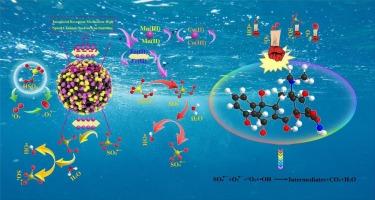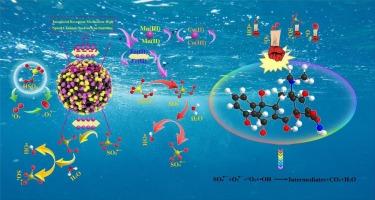高效自组装“双载体”催化剂的制备及其在新兴污染物降解系统中的应用:性能、机制和生态毒性
IF 9
1区 工程技术
Q1 ENGINEERING, CHEMICAL
引用次数: 0
摘要
本研究介绍了一种创新的“组装-热解-重组”策略,利用酚醛树脂衍生碳球(Prc)作为底物。通过将Co-Mn3O4和Mil-53(Fe)纳米材料依次锚定在Prc载体上,该策略同时使Mil-53(Fe)作为Co-Mn3O4的纳米载体,最终合成高性能催化剂Prc@Co-Mn3O4/Mil-53(Fe)。该催化剂在较宽的pH范围内表现出优异的过氧单硫酸盐(PMS)活性,在最佳条件(0.3 g/L催化剂,0.3 mM PMS, pH 7.0, 25 °C)下,在15 min内对四环素(20 mg/L)的降解效率达到100 %,最大降解速率常数(k)为0.1511 min−1。同步辐射分析和密度泛函理论(DFT)计算表明,Mil-53(Fe)纳米载体与Co-Mn3O4在多孔Prc衬底上形成的界面活性位点显著提高了催化性能。以TC为模型污染物,研究揭示了一种非自由基主导的降解机制,主要由单线态氧(1O2)驱动。电子顺磁共振(EPR)和淬火实验验证了活性氧(ROS)的类型和相对贡献。高效液相色谱-质谱(HPLC-MS)鉴定了中间产物,提出了合理的降解途径。毒性评估软件工具(T.E.S.T.)程序进一步评估中间体的生态毒性,预测其环境影响。综上所述,通过“组装-热解-重组”策略合成的Prc@Co-Mn3O4/Mil-53(Fe)催化剂具有独特的“无机载体-金属纳米载体”双重结构。本文章由计算机程序翻译,如有差异,请以英文原文为准。


Fabrication of a highly efficien self-assembled “Dual-Carrier” catalyst and its application in emerging contaminant degradation systems: performance, mechanisms, and ecotoxicity
This study introduces an innovative “assembly-pyrolysis-reassembly” strategy utilizing phenolic resin-derived carbon spheres (Prc) as substrates. By sequentially anchoring Co-Mn3O4 and Mil-53(Fe) nanomaterials onto the Prc carrier, the strategy simultaneously enables Mil-53(Fe) to function as a nanoscale carrier for Co-Mn3O4, ultimately synthesizing the high-performance catalyst Prc@Co-Mn3O4/Mil-53(Fe). The catalyst exhibits exceptional peroxymonosulfate (PMS) activation across a broad pH range, achieving 100 % degradation efficiency for tetracycline (TC, 20 mg/L) within 15 min under optimal conditions (0.3 g/L catalyst, 0.3 mM PMS, pH 7.0, 25 °C), with a maximum degradation rate constant (k) of 0.1511 min−1. Synchrotron radiation analyses and density functional theory (DFT) calculations demonstrate that interfacial active sites formed between the Mil-53(Fe) nanocarriers and Co-Mn3O4 on the porous Prc substrate significantly enhance catalytic performance. Using TC as a model pollutant, the study reveals a non-radical-dominated degradation mechanism, primarily driven by singlet oxygen (1O2). Electron paramagnetic resonance (EPR) and quenching experiments validated the types and relative contributions of reactive oxygen species (ROS). High-performance liquid chromatography-mass spectrometry (HPLC-MS) identified intermediate products, enabling the proposal of plausible degradation pathways. The Toxicity Estimation Software Tool (T.E.S.T.) program further assessed the ecotoxicity of intermediates, predicting their environmental impacts. In summary, the Prc@Co-Mn3O4/Mil-53(Fe) catalyst, synthesized via the “assembly-pyrolysis-reassembly” strategy, features a unique “inorganic carrier-metal nanocarrier” dual architecture.
求助全文
通过发布文献求助,成功后即可免费获取论文全文。
去求助
来源期刊

Separation and Purification Technology
工程技术-工程:化工
CiteScore
14.00
自引率
12.80%
发文量
2347
审稿时长
43 days
期刊介绍:
Separation and Purification Technology is a premier journal committed to sharing innovative methods for separation and purification in chemical and environmental engineering, encompassing both homogeneous solutions and heterogeneous mixtures. Our scope includes the separation and/or purification of liquids, vapors, and gases, as well as carbon capture and separation techniques. However, it's important to note that methods solely intended for analytical purposes are not within the scope of the journal. Additionally, disciplines such as soil science, polymer science, and metallurgy fall outside the purview of Separation and Purification Technology. Join us in advancing the field of separation and purification methods for sustainable solutions in chemical and environmental engineering.
 求助内容:
求助内容: 应助结果提醒方式:
应助结果提醒方式:


